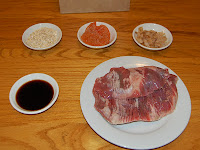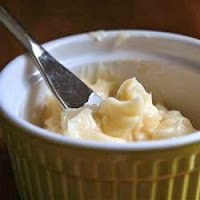 Two weeks ago, I stopped by the restaurant to pick up the bag of secret ingredients and was greeted by “Doc” himself, who seemed intrigued to see what the challengers would come up with. Resisting the urge to open the bag on the spot, I took the goodies home to find five challenge components: beautifully marbled flank steak, quick oats, bonito flakes, candied mango, and Chinkiang vinegar. The flank steak and quick oats were familiar. We also recognized the bonito flakes (dried, fermented and smoked skipjack tuna) as the main ingredient of the Japanese soup base, dashi. The candied mango seemed self-explanatory, but a little nip revealed that not only was it coated in sugar, but in a hint of chili pepper as well. And lastly, the Chinkiang vinegar was a complete mystery. A little research revealed that it is a dark, smoky, slightly sweet black rice vinegar originating from the city of Zhenjiang, China.
Two weeks ago, I stopped by the restaurant to pick up the bag of secret ingredients and was greeted by “Doc” himself, who seemed intrigued to see what the challengers would come up with. Resisting the urge to open the bag on the spot, I took the goodies home to find five challenge components: beautifully marbled flank steak, quick oats, bonito flakes, candied mango, and Chinkiang vinegar. The flank steak and quick oats were familiar. We also recognized the bonito flakes (dried, fermented and smoked skipjack tuna) as the main ingredient of the Japanese soup base, dashi. The candied mango seemed self-explanatory, but a little nip revealed that not only was it coated in sugar, but in a hint of chili pepper as well. And lastly, the Chinkiang vinegar was a complete mystery. A little research revealed that it is a dark, smoky, slightly sweet black rice vinegar originating from the city of Zhenjiang, China.| Instructional Video - See how we did it! |
Our assignment was to create an original recipe using all five of the ingredients. The first step was to decide what type of meal to make. Following the adage “go with what you know,” we immediately thought of Italian cuisine. The dishes were not as obvious as one might suppose since three of the five ingredients are used to make traditional Chinese and Japanese dishes. Initially, we were worried that the Asian ingredients would not complement the ethnic flavors and spices typical of Italian fare, but we were pleasantly surprised with the results. We hope you will be too!
Quick Oat Polenta
1/2 cup quick-cooking oats
1/2 cup cornmeal
2 cups water
Salt to taste (1/2 to 1 teaspoon)
1 bay leaf (optional)
1 tablespoon unsalted butter
¼ cup freshly grated Parmesan (optional)
In a saucepan, combine quick oats, cornmeal, water and a pinch of salt. Add the bay leaf if you are using one. Set pan over medium-high heat and bring to a boil. You will immediately notice the mixture thickening. Reduce the heat to the lowest setting and allow to steam while the agrodolce reduces and you prepare the flank steak.
Candied Mango Agrodolce
2 tablespoons candied mango, chopped
¼ cup Chinkiang (Black rice) vinegar
¼ cup water
2 tablespoons honey
Pinch of salt
Chop the candied mango into ¼-inch pieces and add to a saucepan with the black vinegar and the water. Heat over medium-high setting an add the honey and salt to the pan. Stir well to dissolve the honey in the vinegar. Reduce heat to medium and allow to simmer until the liquid is reduced by half and resembles a syrup.
Flank Steak
 1 lb. flank steak
1 lb. flank steak3 tablespoons bonito flakes
2 teaspoons freshly ground black pepper
1 teaspoon olive oil (for coating pan)
The first step is to grind the bonito flakes into a powder. We used a small coffee grinder, but a mortar and pestle or small food processor. Because the bonito flakes are quite salty with a mild, earthy fish flavor, it will take the place of salt in this recipe. For those who are still hesitant about putting fish flakes on steak, remember that Italians frequently use anchovies and anchovy paste as a seasoning in savory dishes.
 Remove flank steak from packaging and rinse under cold water before patting dry with paper towels. Lay on a plate or cutting board and dust the top with the bonito powder and freshly ground black pepper. You only need to season one side.
Remove flank steak from packaging and rinse under cold water before patting dry with paper towels. Lay on a plate or cutting board and dust the top with the bonito powder and freshly ground black pepper. You only need to season one side.Heat a heavy pan or skillet over high heat and add oil. Swirl the oil to coat the bottom of the pan and heat until tiny wisps of smoke appear above the pan’s surface. Lay the flank steak seasoned side down in the hot pan. Do not be surprised by how loud the sizzling will be. Let the meat sear until the pan side is a crusty-brown. Depending on the thickness of the meat, this should take from 3 to 5 minutes. Turn the meat over and sear the second side until a crust forms. You should not need to cook the second side as long. When seared on both sides, remove the steak from the pan and set aside for 5 minutes to allow the juices to retreat.

While the steak rests, remove the cover from the polenta and check the consistency. If you are adding the Parmesan cheese, now is the time to add it and stir to combine. If the polenta is not cooked to your desired thickness, turn the heat up to medium and cook uncovered until done, stirring constantly. If the polenta is too thick, you can add some more water to thin it to your desired consistency. Drop a pat of butter in and stir in before serving.

This is also the time to double check your agrodolce. As with the polenta, turn up the heat if the sauce is too thin or add a splash of water if it is too thick.
Slice the steak on the bias. Ladle polenta on to serving plated and arrange sliced flank steak on plate. Drizzle the agrodolce sauce over the steak. We chose to serve the candied mango pieces (because they are delicious!), but this is optional. Serve immediately and enjoy!!
We would love to hear how you would have used the secret ingredients. Please comment below with your ideas!


















